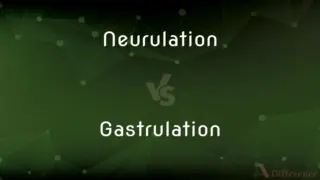Ode vs. Sonnet — What's the Difference?
Edited by Tayyaba Rehman — By Urooj Arif — Updated on April 18, 2024
Odes are lengthy, formal poems focused on a specific subject with a serious tone, while sonnets are 14-line poems with strict rhyme schemes and meter, often exploring themes of love or nature.

Difference Between Ode and Sonnet
Table of Contents
ADVERTISEMENT
Key Differences
An ode is a type of lyrical stanza structured in a formal, elaborate manner to praise or glorify an event, individual, or emotion. In contrast, a sonnet is a concise poem that consists of 14 lines, traditionally written in iambic pentameter and adhering to one of several specific rhyme schemes.
Odes do not follow a fixed pattern or structure and can vary in rhyme and meter, allowing for flexibility in expression. On the other hand, sonnets are known for their strict formal structure, which includes specific rhyme schemes such as Shakespearean or Petrarchan.
The subject matter of odes is often exalted, dealing with noble themes and lofty emotions. Whereas sonnets typically explore intimate emotions, especially the complexities of love and affection, though they can also address other themes like mortality and beauty.
Odes often utilize an elevated language to match their ceremonious themes and purpose, which is fitting for the solemn or celebrative tone they typically convey. Conversely, sonnets, while also elegant, tend to be more direct and personal in their emotional expression.
In terms of historical context, odes have roots in ancient ceremonial poetry, originally intended to be sung. Sonnets evolved during the Renaissance, becoming a popular form to express personal sentiments, particularly in the works of poets like Shakespeare and Petrarch.
ADVERTISEMENT
Comparison Chart
Structure
Variable length and form
Strictly 14 lines, fixed rhyme scheme
Rhyme and Meter
Flexible, often irregular
Typically iambic pentameter
Themes
Celebratory, noble, grandiose
Love, nature, beauty, morality
Tone
Ceremonial, elevated
Personal, reflective
Historical Origins
Ancient Greece, meant for musical accompaniment
Renaissance, perfected by Petrarch and Shakespeare
Compare with Definitions
Ode
A poem meant to be sung or chanted.
Pindaric odes were originally performed with musical accompaniment.
Sonnet
Follows strict rhyme schemes, such as ABAB CDCD EFEF GG.
This structure is characteristic of Shakespearean sonnets.
Ode
A form of stately and elaborate lyrical verse.
Keats' Ode on a Grecian Urn explores themes of art and beauty.
Sonnet
A short lyrical poem of 14 lines.
Shakespeare’s sonnets are some of the most beloved in English literature.
Ode
Often structured in three major parts: the strophe, antistrophe, and epode.
The structural complexity of an ode reflects its ceremonious nature.
Sonnet
Popularized during the Renaissance in Europe.
Petrarch’s sonnets influenced many poets across the continent.
Ode
Can vary in rhyme and meter, providing poetic flexibility.
Modern odes diverge from traditional patterns to suit contemporary themes.
Sonnet
Often deals with themes of love, beauty, and mortality.
Sonnet 18 questions the immortalizing power of poetry.
Ode
Typically used to praise or glorify an event or individual.
Ode to Joy celebrates the ideal of universal brotherhood.
Sonnet
Written in iambic pentameter, a rhythm that mimics the natural flow of speech.
The sonnet’s meter is crucial to its melodious quality.
Ode
An ode (from Ancient Greek: ᾠδή, romanized: ōdḗ) is a type of lyrical stanza. It is an elaborately structured poem praising or glorifying an event or individual, describing nature intellectually as well as emotionally.
Sonnet
A sonnet is a poetic form which originated in the Italian poetry composed at the Court of the Holy Roman Emperor Frederick II in Palermo, Sicily. The 13th-century poet and notary Giacomo da Lentini is credited with the sonnet's invention for expressing courtly love.
Ode
A lyric poem of some length, usually of a serious or meditative nature and having an elevated style and formal stanzaic structure.
Sonnet
A 14-line verse form often in iambic pentameter, having one of several conventional rhyme schemes and usually featuring a shift in mood or tone after the eighth or twelfth line.
Ode
A choric song of classical Greece, often accompanied by a dance and performed at a public festival or as part of a drama.
Sonnet
A poem in this form.
Ode
A classical Greek poem modeled on the choric ode and usually having a three-part structure consisting of a strophe, an antistrophe, and an epode.
Sonnet
A fixed verse form of Italian origin consisting of fourteen lines that are typically five-foot iambics and rhyme according to one of a few prescribed schemes.
Ode
A short poetical composition proper to be set to music or sung; a lyric poem; especially, now, a poem characterized by sustained noble sentiment and appropriate dignity of style.
Write an ode to someone
Sonnet
(intransitive) To compose sonnets.
Ode
A short poetical composition proper to be set to music or sung; a lyric poem; esp., now, a poem characterized by sustained noble sentiment and appropriate dignity of style.
Hangs odes upon hawthorns and elegies on brambles.
O! run; prevent them with thy humble ode,And lay it lowly at his blessed feet.
Sonnet
(transitive) To celebrate in sonnets; to write a sonnet about.
Ode
A lyric poem with complex stanza forms
Sonnet
A short poem, - usually amatory.
He had a wonderful desire to chant a sonnet or hymn unto Apollo Pythius.
Sonnet
A poem of fourteen lines, - two stanzas, called the octave, being of four verses each, and two stanzas, called the sestet, of three verses each, the rhymes being adjusted by a particular rule.
Sonnet
To compose sonnets.
Sonnet
A verse form consisting of 14 lines with a fixed rhyme scheme
Sonnet
Praise in a sonnet
Sonnet
Compose a sonnet
Common Curiosities
What is the main purpose of an ode?
The main purpose of an ode is to formally celebrate or glorify a person, event, or emotion with elaborate and stately language.
What differentiates an ode from other types of poetry?
Odes differ from other types of poetry in their formal, elaborate structure and ceremonious tone, often designed for praising or glorifying their subject.
Can the themes of odes and sonnets overlap?
While themes can overlap, with both forms sometimes exploring abstract concepts like beauty or love, odes are more ceremonial, and sonnets more intimate and reflective.
Why are sonnets popular in romantic literature?
Sonnets are popular in romantic literature due to their concise form and potent ability to express deep, personal emotions and complex thoughts on love.
Who are some famous sonnet writers?
Famous sonnet writers include William Shakespeare, Petrarch, and Elizabeth Barrett Browning.
What is a Pindaric ode?
A Pindaric ode follows the form and style of ancient Greek poet Pindar, known for its formal structure and triadic format.
How is a sonnet structured?
A sonnet is structured into 14 lines, typically written in iambic pentameter, with a fixed rhyme scheme.
Are odes still written today?
Yes, odes continue to be written today, though often in more modern forms that may stray from the strict rules of classical odes.
Can anyone write an ode or a sonnet?
Anyone can write an ode or a sonnet, though mastering the traditional forms and structures can take practice.
Can a sonnet be about death or sadness?
Yes, sonnets can address various themes including mortality and melancholy, often reflecting on the nature of life and loss.
Is a sonnet always romantic?
No, while often associated with romantic themes, sonnets can explore a wide range of subjects including philosophy, politics, and personal reflection.
How does the structure of a sonnet affect its themes?
The strict structure of a sonnet provides a disciplined framework that can intensify the expression of its themes, leading to poignant insights within a limited space.
Why study odes and sonnets in literature?
Studying odes and sonnets enriches understanding of poetic forms, historical contexts, and the diverse ways poets express complex human emotions and experiences.
How do modern odes differ from classical odes?
Modern odes may deviate from the traditional structured patterns of classical odes to better suit contemporary themes and languages.
What are some examples of modern sonnets?
Modern sonnets can be found in the works of poets like Ted Hughes and Seamus Heaney, who have adapted the form to contemporary themes and language.
Share Your Discovery

Previous Comparison
Jam vs. Curd
Next Comparison
Neurulation vs. GastrulationAuthor Spotlight
Written by
Urooj ArifUrooj is a skilled content writer at Ask Difference, known for her exceptional ability to simplify complex topics into engaging and informative content. With a passion for research and a flair for clear, concise writing, she consistently delivers articles that resonate with our diverse audience.
Edited by
Tayyaba RehmanTayyaba Rehman is a distinguished writer, currently serving as a primary contributor to askdifference.com. As a researcher in semantics and etymology, Tayyaba's passion for the complexity of languages and their distinctions has found a perfect home on the platform. Tayyaba delves into the intricacies of language, distinguishing between commonly confused words and phrases, thereby providing clarity for readers worldwide.














































